Juniper is a genus of about 50 - 70 species within the cypress family; they are evergreen coniferous trees or shrubs and are very popular for bonsai purposes. Juniper Bonsai trees sold in garden centres are often Japanese garden junipers (Juniperus procumbens nana) and Juniperus chinensis Blaauws, and Juniperus Squamata.



More suitable and with better end products are the Chinese juniper (Juniperus chinensis) and the Japanese Shimpaku (Juniperus sargentii, as well as the Japanese needle juniper (Juniperus rigida) and two central European species: the savin (Juniperus sabina) the common juniper (Juniperus communis), as well as the Green mound juniper {Juniperus procumbenns – nana).
All junipers have similar care guidelines, but different training or styling techniques.
- The foliage range from dark blue-greens to light greens.
- The foliage can either be scale-like or needle-like.
- Scale junipers usually have needle-like foliage when they are young (called juvenile foliage); the typical scale-like foliage appears later.
- After heavy pruning or bending, overwatering or other stress often juvenile foliage will grow again. It can last a few years until enough normal scale-like foliage has grown and all the needle-like foliage can be removed.
- The berry-like cones are round or oval; depending on the species they measure around 2 cm (1 inch), sometimes down to 3mm, and they need a year or two to ripen. The seeds are round or edged. The cones are often eaten by birds who spread the germinable seeds later with their droppings.
Junipers are very suitable for creating deadwood. This is due to the fact that live veins below a broken branch or a dying branch will dry out and die. This can result in natural deadwood which is peeled, polished and bleached by climatic conditions and is very durable in case of the juniper.
The combination of green foliage, reddish-brown or yellowish-brown bark and silvery white deadwood makes the tree very attractive
Choosing your juniper speciesA. Scale junipers:
The two most popular juniper species for bonsai of the group with scale-like foliage are the Chinese Juniper and the Japanese Shimpaku (which is a variety of the Chinese Juniper originally found in the Japanese mountains). Both have scale-like foliage with a colour ranging from yellowish-green to bluish-green or greyish-green.

Scale juniper juvenile foliage.
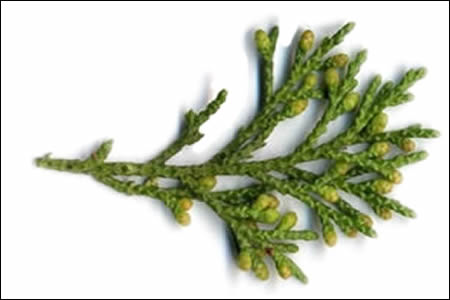
With maturity it develops into the adult foliage.
Amongst the scale junipers the following are the most frequently used:
- The Itoigawa Shimpaku is very popular due to its delicate emerald-green foliage.
- The Blaauws juniper with its rather more coarse blue green foliage is also popular.
B. Needle junipers:
The most popular juniper species with needle-like foliage. The Japanese Needle Juniper has sharp, dark green, stinging needles with a narrow white line along their length. The most common species used are Juniperus procumbens and Juniperus communis:
- Juniperus procumbens nana, the Green Mound Juniper bonsai is also from Japan and also bears needle-like foliage, but the needles are shorter, more compact and a bluish-green - almost like scale-like foliage. This plant grows as a ground covering shrub if it is not shaped.

Juniperus procumbens needles merging smoothly with the stem, not jointed at base. - Juniperus communis, the Common Juniper is native to Europe, especially U.K. and is difficult to acquire as they respond badly to repotting. Digging nearly always leads to death within 3 years, there are so many specimens to be found in the wild that would appear to be a collectors dream, unfortunately they rarely survive. Styling Juniperus communis is notoriously difficult as you cannot wire any new growth; wire can only be applied to branches that have bark so wiring new growth can kill it. Needles are sharp but smaller and more delicate than those of the Japanese Needle Juniper. This needle juniper will create long shoots from every growing tip, not just a couple.
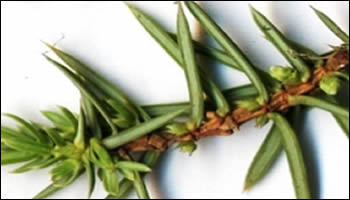
Juniperus communis needles 'jointed' at the base - Juniperus rigida, the Temple juniper, is a species of juniper, native to northern China, Korea, Japan. It is closely related to Juniperus communis It is a shrub or small tree growing to a height of 6 – 10 m and a trunk diameter up to 50 cm. The leaves are evergreen, needle-like, in whorls of three, bright green to yellowish-green, 10–23 mm
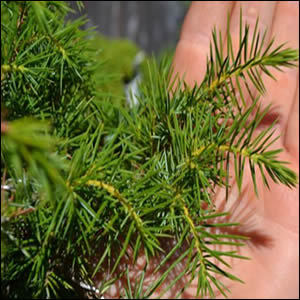
Juniperus rigida are very different with finer needles but equally sharp -
Juniperus squamata, flaky juniper or Himalayan juniper; this is a species of juniper native to the Himalayas and China. It is a coniferous evergreen shrub or a small tree reaching 2 – 10 m tall with flaky brown bark, and a prostrate to irregularly conical crown. The leaves are broad, needle-like, 3 – 9 mm long, arranged in six ranks in alternating whorls of three, strongly glaucous blue-green in colour.
Very vigorous, fast growing and responsive to bonsai techniques but its appearance suffers from the retention of old needles that steadfastly remain on the tree after dying and browning off; they spoil the appearance of the tree. The other point against this species is the prickly, unfriendly nature of the needles, making it painful to work on.


Junipers are a unique species making wonderful bonsai but requiring very specific treatment and training for each species to ensure you get the best from your trees.
There’s a lot of misinformation about junipers.
For starters, needle and scale junipers are maintained in totally different ways.
It’s essential to know what type of juniper you have got so you can train it properly. This really needs to be addressed; there are far too many weakened and dead junipers out there because of a misunderstanding of how we handle their growth — in fact; I doubt I’m far off from suggesting that ‘pinching’ is the number one killer of juniper bonsai.
Junipers build energy from their tips. If we don’t let them grow we’re going to weaken them — and the more finger pinching we do, the more they weaken. That goes for both scale and needle junipers.
Never Pinch Junipers!
- Basically, we do not pinch junipers.
- We cut new long extensions with scissors . . . . . .and I know that will raise some eyebrows. The idea of pinching junipers with fingers probably started long ago in translated Japanese articles written by those who did not specialize in or have much experience in junipers. And then we bought into the idea of pinching because it seemed like a way to have fun with our junipers. But pinching, especially over-pinching, where every growing tip is removed, has been killing junipers for decades.
Juvenile growth on junipers…Cut? Leave alone?
- Juvenile growth in junipers is when the shoots display needle-like growth on a typically scale growth variety.
- This is a scale juniper, showing the past year’s growth as the spiky, juvenile foliage, with the tips transitioning into mature, scale foliage.

Spiky juvenile growth is a response to either:
- too much foliage loss from pinching
- overly hard pruning
- too much fertilizer.
Naturally, since mature scale foliage is nicer to look at, and is what the tree grows when it is content, you might wish to cut off the juvenile off . . . . .don’t!
- Do not cut it - leave the juvenile foliage alone.
- The problem is, if we cut off the juvenile growth, we have likely cut off everything that is new growth on the juniper. That would be deeply, seriously, and really quite intensely bad. A juniper needs its newer foliage to stay healthy and strong.
- When the tree is ready, it will grow scale foliage on the new tips, replacing the juvenile.
- The needles of the juvenile foliage will, over time yellow, brown, and eventually shed.
- It can be a year or two impatient wait for this to happen. You might want to stock up on gloves so you don’t nibble your fingernails of!
Scale junipers particularly Itoigawa are the most likely to revert to juvenile foliage, usually after an over-strong pruning. In short: Leave your juvenile foliage to its own devices; concentrate on other trees to dilute impatience, and try not to repeat past juniper offences.
Look at these examples:
This shimpaku has no need of any kind of foliage restraint. Its’ growth is so slow and contained that it barely changes in size in one year’s time.
Eventually the tree will outgrow itself and then some longer branches will need to be removed, and shorter ones will replace them.

This juniper is also a scale juniper and it has two strong shoots that have started to grow beyond the foliage pad. Unless you want a longer branch, basic juniper maintenance is to take your scissors and cut off these two extensions.
Nothing else needs removing. If you pinch out the remaining slowly growing tips, tree will panic and weaken. Always leave many growing tips on scale junipers — you can cut shoots off, but do not touch the tips of those shoots that remain.
Selective strong shoot removal is only done a couple times a year, no more.
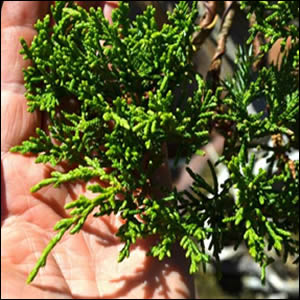

Needle junipers - these have a totally different set of rules for training.
Needle junipers will create long shoots from every growing tip, not just a couple.
- Let all the tips on these trees grow out long.
- Longer is often better to develop the energy of the tree.
- In early summer, cut almost the entire new shoot off.
- On refined trees you may leave 1/16″ or more
A tree growing in good soil with lots of roots and strong shoots will burst out with buds, you get good ramification.
All varieties of junipers need sharp scissors and not fingers but the growth patterns of the two are totally different. Just identify which you have, apply the appropriate technique and your junipers will flourish.
One tip: the needle junipers love water and fertilizer. In the spring they can use as much water as a maple.
While the tree is dormant, nothing will change. The only way to get mature growth is to let the tree grow it. Existing juvenile foliage does not change into mature foliage; the growth habit itself changes once the tree recovers by growing mature foliage beyond the juvenile.

Varieties grown regularly as bonsai:
Juniperus procumbens: Green Mound juniper
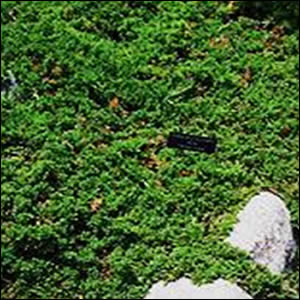

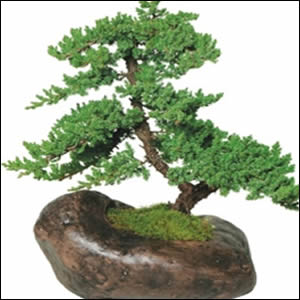
A strong-growing mat-forming 'Green Mound' juniper. The natural movement of this tree's trunk and branches capture the essence of bonsai; making Green Mound a much used juniper variety.

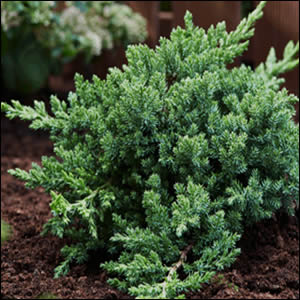
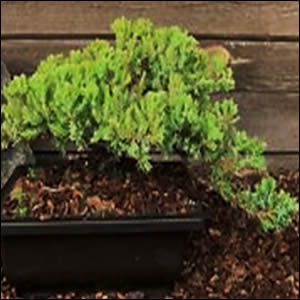
Juniperus Communis: common juniper
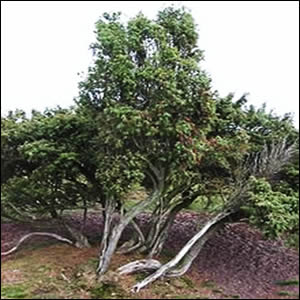

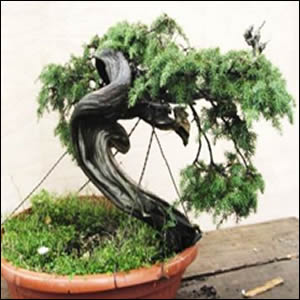
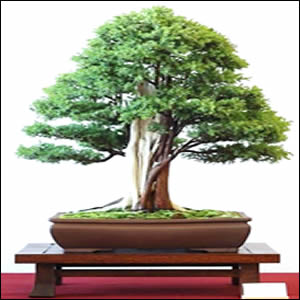
Juniperus Ridgida: Needle juniper
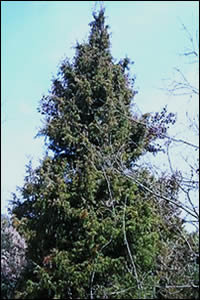


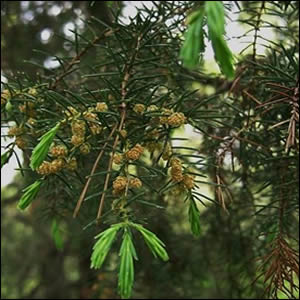

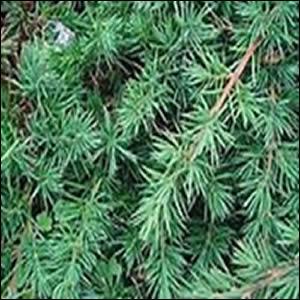
Juniperus Squamata:


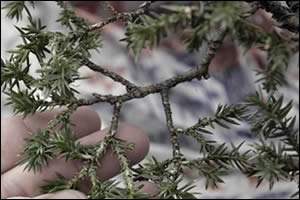

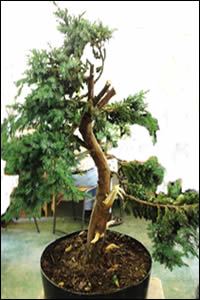

Juniperus chinensis Blaauw: Blaauws juniper
This is a crossbred variety, naturally occurring between a Sabina and a Chinensis and very popular for use as bonsai in the early days of bonsai in the U.K. Easily obtainable raw material from garden centres, this proved a hardy plant and forgiving of the harsh treatment it was given, growing in a style that was naturally splayed out from the root base with a strong bluish green foliage that darkens to a purplish brown in winter.
In the early days of bonsai in Europe the Blaauws juniper was frequently everyone’s ‘first tree'.
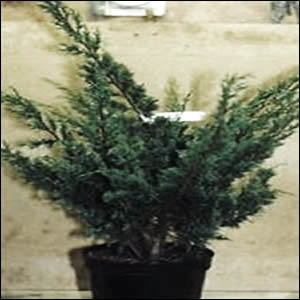

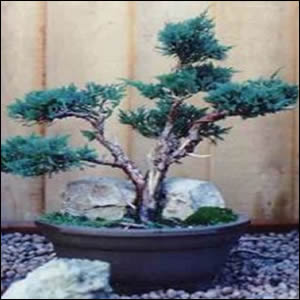

Quoted here from Graham Potter:
“My first ever attempt at styling a tree using wire. This juniper (see below) was obtained from a nursery in 1993.
By 1995 this was the best I had managed. An interesting piece of rock had crossed my path and joined the composition.
Over the following years work consisted of regular deep pruning and thinning once every autumn and trying to balance the vigour in all of the pads. Following the unsuccessful use of several different pots I put the tree on this slab by Brian Albright.
This is 2002. Finally the trees vigour is balanced. Over the winter I completely wired all of the tertiary branches and placed each rosette of foliage in its own space. The branching, when viewed from beneath is exquisite. The slab planting has matured very nicely and evokes a wonderful feeling of landscape.

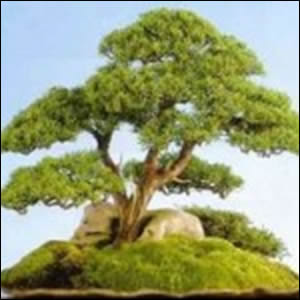
Juniperus chinensis 'Shimpaku' shimpaku juniper
Shimpaku Junipers are one of the most popular species for bonsai within the bonsai community. Its’ attractive foliage and beautiful bark make this one of the best for bonsai. Many wild trees have been collected in Japan, now making it extremely rare to find growing wild. In fact, today the Shimpaku junipers growing in the wild in Japan face extinction due to over collecting.
It is surprising to learn that the Shimpaku juniper so well known today was first found only a little more than 100 years ago in Japan. During that time, due to over-collecting, the Shimpaku growing in the wild have disappeared.

Care instructions for all Juniper bonsai regardless of variety:
- Keep the tree outside, year-round, preferably in a bright sunlit spot. Juniper will not survive indoors. In winter protect the tree below -10 degrees. Some varieties change their foliage colour to a purplish brown in winter; this is their frost protection mechanism. In spring they return to green again.
- Do not water too much as juniper roots do not like soil wetness. Before watering, check the soil – it should be slightly dry. Misting the tree can be done regularly, especially after the tree has been re-potted - it benefits from humidity.
- Frequently check acquired Junipers which are produced for bonsai purposes they will already been wired quite heavily. You need to ensure the wire has been removed and is not seriously cutting in to the bark.
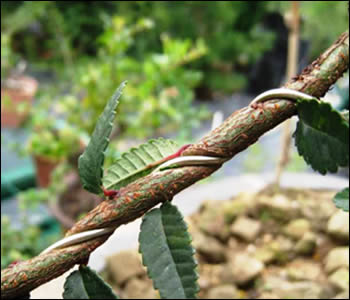
Not a juniper but it happens equally with junipers and does readily heal - Dramatic styles are popular and correspond with the natural shapes that used to grow in the Japanese mountains.
- Junipers can be strongly bent, if necessary wrapped with raffia or tape as a protection. The foliage pads should be wired and fanned out after thinning, to allow light and air in or the inner parts of the foliage pads will die.
- Repot every two years; very old trees can be left longer; use a basic well drained soil mix.
- Do not prune the roots too aggressively.
- If junipers are well cared for and placed in an ideal position they are fairly resistant against pests. It is important though not to let the foliage pads get too dense, because otherwise pests can settle in them more easily.
Specimen Junipers

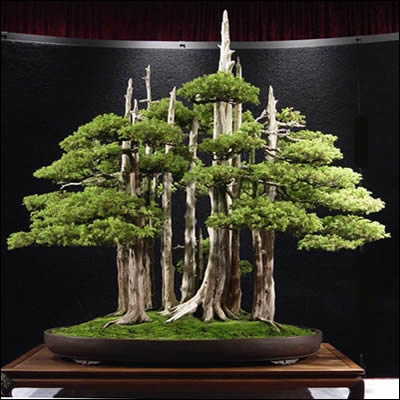
John Naka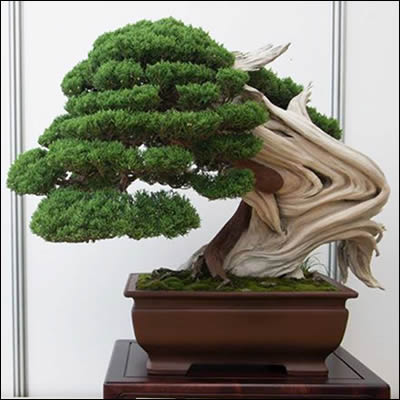
Crespi Cup 2015 Gino Costa
Isao Omachi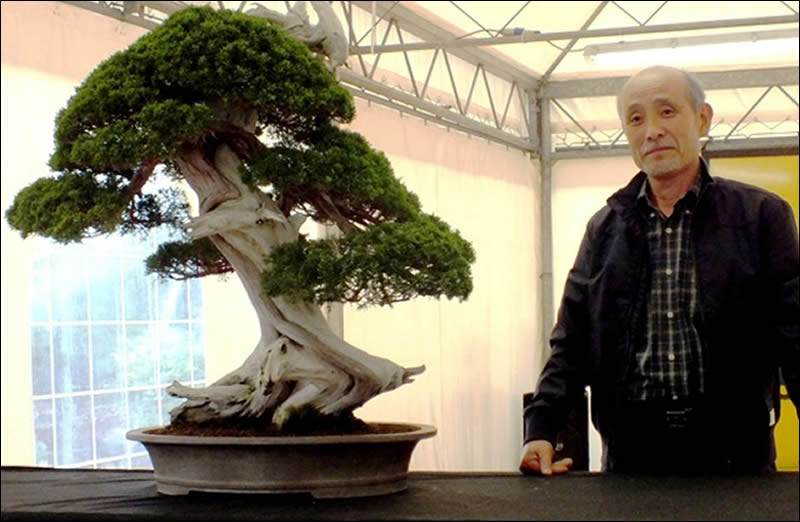
Crespi Cup 2012: Takeo Kawabe with his demonstration Juniper.
Web design: nysys